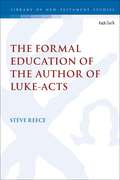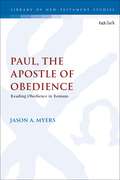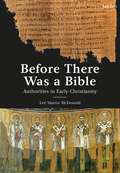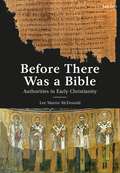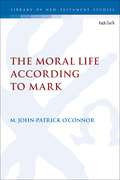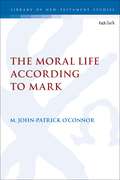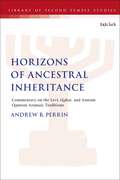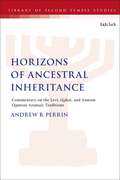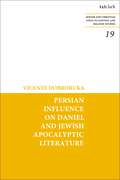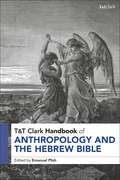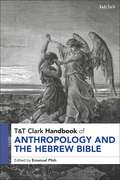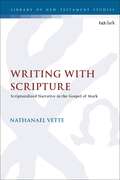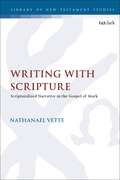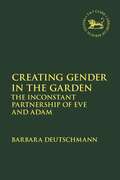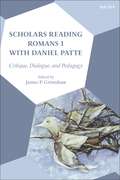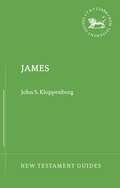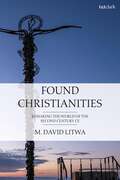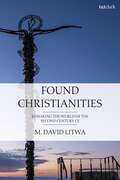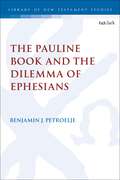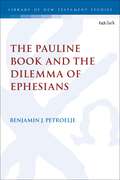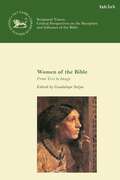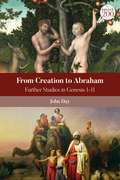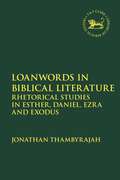- Table View
- List View
The Formal Education of the Author of Luke-Acts (The Library of New Testament Studies)
by Steve ReeceSteve Reece proposes that the author of Luke-Acts was trained as a youth in the primary and secondary Greek educational curriculum typical of the Eastern Mediterranean during the Roman Imperial period, where he gained familiarity with the Classical and Hellenistic authors whose works were the focus of study. He makes a case for Luke's knowledge of these authors internally by spotlighting the density of allusions to them in the narrative of Luke-Acts, and externally by illustrating from contemporary literary, papyrological, and artistic evidence that the works of these authors were indeed widely known in the Eastern Mediterranean at the time of the composition of Luke-Acts, not only in the schools but also among the general public.Reece begins with a thorough examination of the Greek educational system during the Hellenistic and Roman Imperial periods, emphasizing that the educational curriculum was very homogeneous, at least at the primary and secondary levels, and that children growing up anywhere in the Eastern Mediterranean could expect to receive quite similar educations. His close examination of the Greek text of Luke-Acts has turned up echoes, allusions, and quotations of several of the very authors that were most prominently featured in the school curriculum: Homer, Aesop, Euripides, Plato, and Aratus. This reinforces the view that Luke, along with other writers of the New Testament, lived in a cultural milieu that was influenced by Classical and Hellenistic Greek literature and that he was not averse to invoking that literature when it served his theological and literary purposes.
Paul, The Apostle of Obedience: Reading Obedience in Romans (The Library of New Testament Studies)
by Jason A. MyersJason A. Myers reconsiders the meaning and context of the phrase “the obedience of faith” in Rom 1:5 and how it contributes to the theme of obedience in Romans. In contrast to previous studies that have nearly exclusively focused on the obedience language in light of the Hebrew Bible and Second Temple literature, Myers instead investigates how this language functioned within the Greco-Roman world, particularly in the discourse of the Roman Empire.By studying both the Greco-Roman contexts and the use of obedience language during the Empire, Myers sheds fresh light on the meaning of “the obedience of faith,” and concludes that such examination helps contemporary readers understand how Gentiles in Paul's audience would have heard and received the terms and images relating to obedience. In addition, he argues that Paul's use of obedience language, both at the beginning and end of Romans (1:5; 15:18), serves as rhetorical bookends, and signals a theme that is central to Paul's purpose in Romans and integral to his calling as an apostle to the Gentiles.
Paul, The Apostle of Obedience: Reading Obedience in Romans (The Library of New Testament Studies)
by Jason A. MyersJason A. Myers reconsiders the meaning and context of the phrase “the obedience of faith” in Rom 1:5 and how it contributes to the theme of obedience in Romans. In contrast to previous studies that have nearly exclusively focused on the obedience language in light of the Hebrew Bible and Second Temple literature, Myers instead investigates how this language functioned within the Greco-Roman world, particularly in the discourse of the Roman Empire.By studying both the Greco-Roman contexts and the use of obedience language during the Empire, Myers sheds fresh light on the meaning of “the obedience of faith,” and concludes that such examination helps contemporary readers understand how Gentiles in Paul's audience would have heard and received the terms and images relating to obedience. In addition, he argues that Paul's use of obedience language, both at the beginning and end of Romans (1:5; 15:18), serves as rhetorical bookends, and signals a theme that is central to Paul's purpose in Romans and integral to his calling as an apostle to the Gentiles.
Before There Was a Bible: Authorities in Early Christianity
by Lee Martin McDonaldHow did authority function before the bible as we know it emerged? Lee Martin McDonald examines the authorities that existed from the Church's beginning: the appeal to the texts containing the words of Jesus, and that would become the New Testament, the not yet finalized Hebrew Scriptures (referred to mostly in Greek) and the apostolic leadership of the churches.McDonald traces several sacred core traditions that broadly identified the essence of Christianity before there was a bible summarized in early creeds, hymns and spiritual songs, baptismal and Eucharistic affirmations, and in lectionaries and catalogues from the fourth century and following. McDonald shoes how those traditions were included in the early Christian writings later recognized as the New Testament. He also shows how Christians were never fully agreed on the scope of their Old Testament canon (Hebrew scriptures) and that it took centuries before there was universal acceptance of all of the books now included in the Christian bible. Further, McDonald shows that whilst writings such as the canonical gospels were read as authoritative texts likely from their beginning, they were not yet called or cited as scripture. What was cited in an authoritative manner were the words of Jesus in those texts, alongside the multiple affirmations and creeds that were circulated in the early Church and formed its key authorities and core sacred traditions.
Before There Was a Bible: Authorities in Early Christianity
by Lee Martin McDonaldHow did authority function before the bible as we know it emerged? Lee Martin McDonald examines the authorities that existed from the Church's beginning: the appeal to the texts containing the words of Jesus, and that would become the New Testament, the not yet finalized Hebrew Scriptures (referred to mostly in Greek) and the apostolic leadership of the churches.McDonald traces several sacred core traditions that broadly identified the essence of Christianity before there was a bible summarized in early creeds, hymns and spiritual songs, baptismal and Eucharistic affirmations, and in lectionaries and catalogues from the fourth century and following. McDonald shoes how those traditions were included in the early Christian writings later recognized as the New Testament. He also shows how Christians were never fully agreed on the scope of their Old Testament canon (Hebrew scriptures) and that it took centuries before there was universal acceptance of all of the books now included in the Christian bible. Further, McDonald shows that whilst writings such as the canonical gospels were read as authoritative texts likely from their beginning, they were not yet called or cited as scripture. What was cited in an authoritative manner were the words of Jesus in those texts, alongside the multiple affirmations and creeds that were circulated in the early Church and formed its key authorities and core sacred traditions.
The Moral Life According to Mark (The Library of New Testament Studies)
by M. John-Patrick O’ConnorM. John-Patrick O'Connor proposes that - in contrast to recent contemporary scholarship that rarely focuses on the ethical implications of discipleship and Christology - Mark's Gospel, as our earliest life of Jesus, presents a theological description of the moral life.Arguing for Mark's ethical validity in comparison to Matthew and Luke, O'Connor begins with an analysis of the moral environment of ancient biographies, exploring what types of Jewish and Greco-Romanic conceptions of morality found their way into Hellenistic biographies. Turning to the Gospel's own examples of morality, O'Connor examines moral accountability according to Mark, including moral reasoning, the nature of a world in conflict, and accountability in both God's family and to God's authority. He then turns to images of the accountable self, including an analysis of virtues and virtuous practices within the Gospel. O'Connor concludes with the personification of evil, human responsibility, punitive consequences, and evil's role in Mark's moral landscape.
The Moral Life According to Mark (The Library of New Testament Studies)
by M. John-Patrick O’ConnorM. John-Patrick O'Connor proposes that - in contrast to recent contemporary scholarship that rarely focuses on the ethical implications of discipleship and Christology - Mark's Gospel, as our earliest life of Jesus, presents a theological description of the moral life.Arguing for Mark's ethical validity in comparison to Matthew and Luke, O'Connor begins with an analysis of the moral environment of ancient biographies, exploring what types of Jewish and Greco-Romanic conceptions of morality found their way into Hellenistic biographies. Turning to the Gospel's own examples of morality, O'Connor examines moral accountability according to Mark, including moral reasoning, the nature of a world in conflict, and accountability in both God's family and to God's authority. He then turns to images of the accountable self, including an analysis of virtues and virtuous practices within the Gospel. O'Connor concludes with the personification of evil, human responsibility, punitive consequences, and evil's role in Mark's moral landscape.
Horizons of Ancestral Inheritance: Commentary on the Levi, Qahat, and Amram Qumran Aramaic Traditions (The Library of Second Temple Studies)
by Andrew B. PerrinIn this study of the Aramaic materials at Qumran, Andrew B. Perrin examines the Aramaic Levi Document, Words of Qahat, and Visions of Amram, showing how they exhibit a concentration of priestly concerns/knowledge and exploring new models for evaluating their potential textual or traditional connections. The Aramaic texts among the Dead Sea Scrolls are among the most understudied items in the Qumran collection, and with open questions posed around their origins, transmission, and reception in and beyond the Second Temple period, these writings provide both new materials and fresh insight into the thought, identity, and practice of ancient Judaism.Perrin's analysis includes a new transcription, critical notes, and translation of the Aramaic Levi, Qahat, and Amram fragments based upon the latest digital images. He pairs them with a comprehensive commentary on the conceptual elements, codicological features, and cultural contexts of the materials, and he concludes with a fresh synthesis regarding the textual formation of these Aramaic, priestly pseudepigrapha as a “constellation” of texts within a larger world or scribal-priestly activity and traditions.
Horizons of Ancestral Inheritance: Commentary on the Levi, Qahat, and Amram Qumran Aramaic Traditions (The Library of Second Temple Studies)
by Andrew B. PerrinIn this study of the Aramaic materials at Qumran, Andrew B. Perrin examines the Aramaic Levi Document, Words of Qahat, and Visions of Amram, showing how they exhibit a concentration of priestly concerns/knowledge and exploring new models for evaluating their potential textual or traditional connections. The Aramaic texts among the Dead Sea Scrolls are among the most understudied items in the Qumran collection, and with open questions posed around their origins, transmission, and reception in and beyond the Second Temple period, these writings provide both new materials and fresh insight into the thought, identity, and practice of ancient Judaism.Perrin's analysis includes a new transcription, critical notes, and translation of the Aramaic Levi, Qahat, and Amram fragments based upon the latest digital images. He pairs them with a comprehensive commentary on the conceptual elements, codicological features, and cultural contexts of the materials, and he concludes with a fresh synthesis regarding the textual formation of these Aramaic, priestly pseudepigrapha as a “constellation” of texts within a larger world or scribal-priestly activity and traditions.
Persian Influence on Daniel and Jewish Apocalyptic Literature (Jewish and Christian Texts)
by Vicente DobrorukaVicente Dobroruka explores Iranian influence on Second Temple Judaism, providing a new explanation of Persian culture and history in the context of biblical accounts by focusing on the spread of Zoroastrian ideas in the period c.300 BCE–200 CE.Dobroruka begins his investigation with an overview of the problems posed by a dualistic worldview-he examines the Indo-European origins of Zarathushtra and his ideas, explores the long-term implications for the notion of free-will, and clarifies the lightness/darkness paradigm that originated in Persia. Following this, Dobroruka discusses a variety of concepts that illustrate this influence, such as the role of matter and the material world, aspects of dualism and the cosmic struggle, the perspectives on the rewards for the just and the opposing punishments for the wicked, the idea of an 'Anointed One', shamanistic visionary experience, the resurrection, and the concepts of Sheol and Paradise.
T&T Clark Handbook of Anthropology and the Hebrew Bible
by Emanuel PfohThis handbook presents an overview of the main approaches from social and cultural anthropology to the Hebrew Bible. Since the late 19th century, biblical scholarship has addressed issues and themes related to biblical stories from a perspective which could now be considered socio-anthropological. It is however only since the 1960s that biblical scholars have started to produce readings and incorporate analytical models drawn directly from social anthropology to widen the interpretive scope of the social and historical data contained in the biblical sources. The handbook is arranged into two main thematic parts. Part 1 assesses the place of the Bible in social anthropology, examines the contribution of ethnoarchaeology to the recovery of the social world of Iron Age Palestine and offers insights from the anthropology of the Mediterranean for the interpretation of the biblical stories.Part 2 provides a series of case studies on anthropological themes arising in the Hebrew Bible. These include kinship and social organisation, death, cultural and collective memory, and ritualism. Contributors also examine how the biblical stories reveal dynamics of power and authority, gender, and honour and shame, and how socio-anthropological approaches can reveal these narratives and deepen our knowledge of the human societies and cultural context of the texts. Bringing together the expertise of scholars of the Hebrew Bible and Biblical Archaeology, this ethnographic introduction prompts new questions into our understanding of anthropology and the Bible.
T&T Clark Handbook of Anthropology and the Hebrew Bible
This handbook presents an overview of the main approaches from social and cultural anthropology to the Hebrew Bible. Since the late 19th century, biblical scholarship has addressed issues and themes related to biblical stories from a perspective which could now be considered socio-anthropological. It is however only since the 1960s that biblical scholars have started to produce readings and incorporate analytical models drawn directly from social anthropology to widen the interpretive scope of the social and historical data contained in the biblical sources. The handbook is arranged into two main thematic parts. Part 1 assesses the place of the Bible in social anthropology, examines the contribution of ethnoarchaeology to the recovery of the social world of Iron Age Palestine and offers insights from the anthropology of the Mediterranean for the interpretation of the biblical stories.Part 2 provides a series of case studies on anthropological themes arising in the Hebrew Bible. These include kinship and social organisation, death, cultural and collective memory, and ritualism. Contributors also examine how the biblical stories reveal dynamics of power and authority, gender, and honour and shame, and how socio-anthropological approaches can reveal these narratives and deepen our knowledge of the human societies and cultural context of the texts. Bringing together the expertise of scholars of the Hebrew Bible and Biblical Archaeology, this ethnographic introduction prompts new questions into our understanding of anthropology and the Bible.
Writing With Scripture: Scripturalized Narrative in the Gospel of Mark (The Library of New Testament Studies #670)
by Nathanael VetteNathanael Vette proposes that the Gospel of Mark, like other narrative works in the Second Temple period, uses the Jewish scriptures as a model to compose episodes and tell a new story. Vette compares Mark's use of scripture with roughly contemporary works like Pseudo-Philo, the Genesis Apocryphon, 1 Maccabees, Judith, and the Testament of Abraham; diverse texts which, combined, support the existence of shared compositional techniques. This volume identifies five scripturalized narratives in the Gospel: Jesus' forty-day sojourn in the wilderness and call of the disciples; the feeding of the multitudes; the execution of John the Baptist; and the Crucifixion of Jesus. This fresh understanding of how the Jewish scriptures were used to compose new narratives across diverse genres in the Second Temple period holds important lessons for how scholars read the Gospel of Mark. Instead of treating scriptural allusions and echoes as keys which unlock the hidden meaning of the Gospel, Vette argues that Mark often uses the Jewish scriptures simply for their ability to tell a story.
Writing With Scripture: Scripturalized Narrative in the Gospel of Mark (The Library of New Testament Studies #670)
by Nathanael VetteNathanael Vette proposes that the Gospel of Mark, like other narrative works in the Second Temple period, uses the Jewish scriptures as a model to compose episodes and tell a new story. Vette compares Mark's use of scripture with roughly contemporary works like Pseudo-Philo, the Genesis Apocryphon, 1 Maccabees, Judith, and the Testament of Abraham; diverse texts which, combined, support the existence of shared compositional techniques. This volume identifies five scripturalized narratives in the Gospel: Jesus' forty-day sojourn in the wilderness and call of the disciples; the feeding of the multitudes; the execution of John the Baptist; and the Crucifixion of Jesus. This fresh understanding of how the Jewish scriptures were used to compose new narratives across diverse genres in the Second Temple period holds important lessons for how scholars read the Gospel of Mark. Instead of treating scriptural allusions and echoes as keys which unlock the hidden meaning of the Gospel, Vette argues that Mark often uses the Jewish scriptures simply for their ability to tell a story.
Creating Gender in the Garden: The Inconstant Partnership of Eve and Adam (The Library of Hebrew Bible/Old Testament Studies)
by Barbara DeutschmannWhat can explain the persistence of gender inequality throughout history? Do narratives such as the Eden story explain that dissymmetry or contribute to it? This book suggests that the Hebrew Bible began and has sustained a rich conversation about sex and gender throughout its life. A literary study of the Garden of Eden story reveals a focus on the human partnership as integral to the divine creation project. Texts from other Hebrew Bible genres build a picture of robust and flexible partnerships within a patriarchal framework.In popular culture, Eve still carries the stench of guilt while Adam, seemingly unscathed by Eden events, remains a positive symbol of manhood. This book helps explain why they have had such different histories. The book also charts the subversive alternate streams of interpretation of women's writings and rabbinic texts.The story of Adam and Eve demonstrates how conceptions of gender in both ancient and modern worlds reflect larger philosophical schemes. Far from existing as timeless verities, female and male relations are constructed according to cultural imperatives of the day. Understanding the different ways that Adam and Eve have been conceived gives us perspective on our own twenty-first century gender architecture.
Scholars Reading Romans 1 with Daniel Patte: Critique, Dialogue, and Pedagogy
by James P. GrimshawA creative collection of essays that introduces, critiques, and dialogues with Daniel Patte's ground-breaking work Romans: Three Exegetical Interpretations and the History of Reception: Volume 1: Romans 1:1-32 (T&T Clark, 2018). Nine scholars from different cultural and methodological perspectives engage with Patte's work, critique his methodology and ethic of interpretation, and develop alternative readings. The first part introduces the format of Patte's book and the three historical interpretations: forensic, covenantal, and realized-apocalyptic. Part two debates methodology and ethical responsibility. The third part focuses on Romans 1:16-18 and 1:26-27 and includes a Confucian Chinese reading and a call for joint biblical and social-science research on the role of Romans in current public policy debates. The final part includes a chapter on pedagogy regarding how Patte's book can be used in the classroom. The final chapter is a powerful description by Patte himself of the various life experiences that shaped his reading of Romans. This book is a critical and communal conversation with Patte on the history of reception of Romans 1 and an example of the necessity of conversations among diverse interpreters that, as Patte says, “reflect the diversity of the modes of our human experience”.
Scholars Reading Romans 1 with Daniel Patte: Critique, Dialogue, and Pedagogy
A creative collection of essays that introduces, critiques, and dialogues with Daniel Patte's ground-breaking work Romans: Three Exegetical Interpretations and the History of Reception: Volume 1: Romans 1:1-32 (T&T Clark, 2018). Nine scholars from different cultural and methodological perspectives engage with Patte's work, critique his methodology and ethic of interpretation, and develop alternative readings. The first part introduces the format of Patte's book and the three historical interpretations: forensic, covenantal, and realized-apocalyptic. Part two debates methodology and ethical responsibility. The third part focuses on Romans 1:16-18 and 1:26-27 and includes a Confucian Chinese reading and a call for joint biblical and social-science research on the role of Romans in current public policy debates. The final part includes a chapter on pedagogy regarding how Patte's book can be used in the classroom. The final chapter is a powerful description by Patte himself of the various life experiences that shaped his reading of Romans. This book is a critical and communal conversation with Patte on the history of reception of Romans 1 and an example of the necessity of conversations among diverse interpreters that, as Patte says, “reflect the diversity of the modes of our human experience”.
James: Methodological Reassessments Of The Letter Of James (New Testament Guides #342)
by John S. KloppenborgJames offers a concise and accessible introduction to a New Testament text, in this case aimed specifically at undergraduate-level students. John S. Kloppenborg introduces the reader to a series of critical issues bearing on the reading of James and provides a balanced presentation and assessment of the range of scholarly views, with guidance for further reading and research.
Found Christianities: Remaking the World of the Second Century CE
by M. David LitwaM. David Litwa tells the stories of the early Christians whose religious identity was either challenged or outright denied. In the second century many different groups and sects claimed to be the only Orthodox or authentic version of Christianity, and Litwa shows how those groups and figures on the side of developing Christian Orthodoxy often dismissed other versions of Christianity by refusing to call them “Christian”. However, the writings and treatises against these groups contain fascinating hints of what they believed, and why they called themselves Christian.Litwa outlines these different groups and the controversies that surrounded them, presenting readers with an overview of the vast tapestry of beliefs that made up second century Christianity. By moving beyond notions of “gnostic”, “heretical” and “orthodox” Litwa allows these “lost Christianities” to speak for themselves. He also questions the notion of some Christian identities “surviving” or “perishing”, arguing that all second century "Catholic" groups look very different to any form of modern Roman Catholicism. Litwa shows that countless discourses, ideas, and practices are continually recycled and adapted throughout time in the building of Christian identities, and indeed that the influence of so-called “lost” Christianities can still be felt today.
Found Christianities: Remaking the World of the Second Century CE
by M. David LitwaM. David Litwa tells the stories of the early Christians whose religious identity was either challenged or outright denied. In the second century many different groups and sects claimed to be the only Orthodox or authentic version of Christianity, and Litwa shows how those groups and figures on the side of developing Christian Orthodoxy often dismissed other versions of Christianity by refusing to call them “Christian”. However, the writings and treatises against these groups contain fascinating hints of what they believed, and why they called themselves Christian.Litwa outlines these different groups and the controversies that surrounded them, presenting readers with an overview of the vast tapestry of beliefs that made up second century Christianity. By moving beyond notions of “gnostic”, “heretical” and “orthodox” Litwa allows these “lost Christianities” to speak for themselves. He also questions the notion of some Christian identities “surviving” or “perishing”, arguing that all second century "Catholic" groups look very different to any form of modern Roman Catholicism. Litwa shows that countless discourses, ideas, and practices are continually recycled and adapted throughout time in the building of Christian identities, and indeed that the influence of so-called “lost” Christianities can still be felt today.
The Pauline Book and the Dilemma of Ephesians (The Library of New Testament Studies)
by Benjamin J. PetroeljeBenjamin J. Petroelje argues that how one reads Ephesians is a function of deeper questions about how to read the Pauline book. Petroelje suggests the contemporary consensus-that Ephesians depicts development of/away from the “real Paul”-is largely a construct of modern criticism, rooted in shifting strategies about how to read a letter collection that developed in the 19th-century.Using Ephesians 3:1-13 as a point of analysis, Petroelje theorizes that the text's “image of Paul” not only anticipates recent revisionist interpretations of Paul's Jewish identity and gentile gospel, but also holds together tensions in the collection itself surrounding these questions. By analysing ancient letter collections beside their own hermeneutical priorities, and applying this method to the late-antique and modern reception of the corpus Paulinum, Petroelje is able to historicize the origins of the split of Paul's corpus, revealing the constructed nature of the critical consensus on Ephesians and the effect that such modern reading strategies have on interpreting the letter. Urging a return to reading Ephesians alongside Pauline co-texts, Petroelje advocates for Ephesians as a crucial source for the study of Paul, whether Paul wrote it or not.
The Pauline Book and the Dilemma of Ephesians (The Library of New Testament Studies)
by Benjamin J. PetroeljeBenjamin J. Petroelje argues that how one reads Ephesians is a function of deeper questions about how to read the Pauline book. Petroelje suggests the contemporary consensus-that Ephesians depicts development of/away from the “real Paul”-is largely a construct of modern criticism, rooted in shifting strategies about how to read a letter collection that developed in the 19th-century.Using Ephesians 3:1-13 as a point of analysis, Petroelje theorizes that the text's “image of Paul” not only anticipates recent revisionist interpretations of Paul's Jewish identity and gentile gospel, but also holds together tensions in the collection itself surrounding these questions. By analysing ancient letter collections beside their own hermeneutical priorities, and applying this method to the late-antique and modern reception of the corpus Paulinum, Petroelje is able to historicize the origins of the split of Paul's corpus, revealing the constructed nature of the critical consensus on Ephesians and the effect that such modern reading strategies have on interpreting the letter. Urging a return to reading Ephesians alongside Pauline co-texts, Petroelje advocates for Ephesians as a crucial source for the study of Paul, whether Paul wrote it or not.
Women of the Bible: From Text to Image (The Library of Hebrew Bible/Old Testament Studies)
The Hebrew Bible and art reside at the core of this book, which analyzes the iconographic representation of several women of the Bible. The contributors consider the ways in which the biblical texts regarding these women had been read and understood throughout time and the means by which they were represented. Each study also explores the different values associated with these representations according to the problems, worries and concerns of each period. Drawing upon disciplines such as theology, philology or history of art, the essays within this volume provide a cross-sectional, plural and rich approach. In focusing upon iconographic representation, numerous visual cultures of the last millennium are explored, and special emphasis is placed upon several integral biblical women such as Bathsheba, Moses' mother, the Pharaoh's Daughter, Ruth, Naomi and Deborah, and their lasting influence upon Western art and culture. This book pursues an understanding of the history of the transmission and reception of the Bible in general, and of the women of the Old Testament in particular.
From Creation to Abraham: Further Studies in Genesis 1-11 (The Library of Hebrew Bible/Old Testament Studies)
by John DayJohn Day investigates disputed points of interpretation within Genesis 1-11, expanding on his earlier book From Creation to Babel with 11 stimulating essays. Day considers the texts within their Near Eastern contexts, and pays particular attention to the later history of interpretation and reception history.Topics covered include the meaning of the Bible's first verse and what immediately follows, as well as what it means that humanity is made in the image of God. Further chapters examine the Garden of Eden, the background and role of the serpent and the ambiguous role of Wisdom; the many problems of interpretation in the Cain and Abel story, as well as what gave rise to this story; how the Covenant with Noah and the Noachic commandments, though originally separate, became conflated in some later Jewish thought; and the location of 'Ur of the Chaldaeans', Abraham's alleged place of origin, and how this was later misinterpreted by Jewish, Christian and Islamic sources as referring to a 'fiery furnace of the Chaldaeans'. These chapters, which illuminate the meaning, background and subsequent interpretation of the Book of Genesis, pave the way for Day's forthcoming ICC commentary on Genesis 1-11.
Loanwords in Biblical Literature: Rhetorical Studies in Esther, Daniel, Ezra and Exodus (The Library of Hebrew Bible/Old Testament Studies)
by Jonathan ThambyrajahIn contrast to previous scholarship which has approached loanwords from etymological and lexicographic perspectives, Jonathan Thambyrajah considers them not only as data but as rhetorical elements of the literary texts of which they are a part. In the book, he explains why certain biblical texts strongly prefer to use loanwords whereas others have few. In order to explore this, he studies the loanwords of Esther, Daniel, Ezra and Exodus, considering their impact on audiences and readers. He also analyzes and evaluates the many proposed loan hypotheses in Biblical Hebrew and proposes further or different hypotheses.Loanwords have the potential to carry associations with its culture of origin, and as such are ideal rhetorical tools for shaping a text's audience's view of the nations around them and their own nation. Thambyrajah also focuses on this phenomenon, looking at the court tales in Esther and Daniel, the correspondence in the Hebrew and Aramaic sections of Ezra 1–7, and the accounts of building the tabernacle in Exodus, and paying close attention to how these texts present ethnicity.
